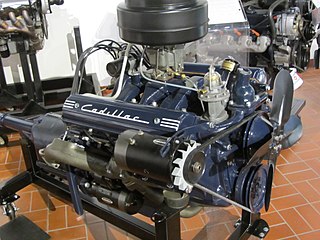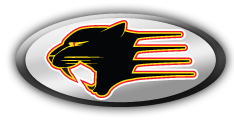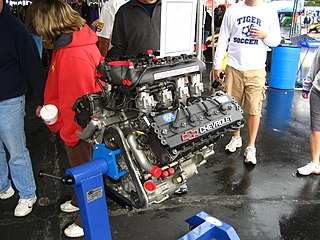Related Research Articles

The Oldsmobile Aurora is a luxury sedan, manufactured and marketed by General Motors from 1994 until 2003 over two generations — sharing platforms with Buick Riviera and using the Cadillac-derived G platform. At the time of production, the Aurora was the flagship vehicle in the Oldsmobile lineup. It originated as the 1989 Oldsmobile tube car concept.

The Northstar engine is a family of high-performance 90° V engines produced by General Motors between 1993 and 2011. Regarded as GM's most technically complex engine, the original double overhead cam, four valve per cylinder, aluminum block/aluminum head V8 design was developed by Oldsmobile R&D, but is most associated with Cadillac's Northstar series.

The term Cadillac V8 may refer to any of a number of V8 engines produced by the Cadillac division of General Motors since it pioneered the first such mass-produced engine in 1914.

Roberto José Guerrero Isaza is a Colombian-American former race driver. He participated in 29 Formula One Grands Prix, debuting on 23 January 1982, becoming the first Colombian to start a Formula One Grand Prix.

Dallara Group S.r.l. is the largest multi-national Italian race car manufacturer, founded by its current President, Giampaolo Dallara. After working for Ferrari, Maserati, Lamborghini and De Tomaso, in 1972 in his native village of Varano de' Melegari (Parma), he created Dallara Automobili.

Team Penske is an American professional auto racing organization, competing in the IndyCar Series, NASCAR Cup Series, IMSA SportsCar Championship and FIA World Endurance Championship. Debuting at the 1966 24 Hours of Daytona, the organization has also competed in various other types of professional racing such as Formula One, Can-Am, Trans Am, and Australia's Supercars Championship. Altogether, Team Penske has earned over 500 victories and over 40 championships in all of auto racing. Team Penske is a division of Penske Corporation, and is owned and chaired by Roger Penske. The team president is Tim Cindric.
Gregory Ray is an American former race car driver.

Panther Racing was an American open wheel auto racing team. It was one of the oldest continually operating teams in the IndyCar Series.

The IndyCar Series, currently known as the NTT IndyCar Series under sponsorship, is the highest class of American open-wheel car racing in the United States, which has been conducted under the auspices of various sanctioning bodies since 1920 after two initial attempts in 1905 and 1916. The series is self-sanctioned by its parent company, IndyCar, LLC., which began in 1996 as the Indy Racing League (IRL) and was created by then Indianapolis Motor Speedway owner Tony George as a competitor to Championship Auto Racing Teams (CART). In 2008, the IndyCar Series merged with CART's successor, the Champ Car World Series and the history and statistics of both series, as well as those from its predecessors, were unified.

Élan Motorsport Technologies is an American enterprise that serves as an umbrella company containing the race car engineering, development and manufacturing companies owned by American racing and automotive company conglomerate Panoz Motor Sports Group. Élan engineers, designs and builds Panoz-branded race cars and components. Since its founding it has also acquired several manufacturers, including famous Formula Ford builders Van Diemen and IndyCar Series constructor G-Force. Élan-built cars have successfully competed in the American Le Mans Series, Le Mans Series, IMSA Prototype Lites and various other championships, racing series and types of professional racing throughout the world. It designs, develops and manufactures full line race cars, i.e. chassis, bodies, components and engines for professional racing competition for a variety of segments and classes.

The Cadillac Northstar LMP was a series of Le Mans Prototypes built by Cadillac for use in the American Le Mans Series as well as an attempt to return Cadillac to the 24 Hours of Le Mans since they first entered in 1950. The Northstar LMPs were named after the Northstar V8 engines which powered them. The Cadillac project ran from 2000 until 2002 when General Motors decided to cancel the project to concentrate solely on their Chevrolet Corvette program. Cadillac returned to prototype racing in 2017 with the Cadillac DPi-V.R in the WeatherTech SportsCar Championship.
The Louis Schwitzer Award is presented by the Indiana Section of SAE International to an engineer or team of engineers "for their innovative design and engineering excellence" and acknowledges "engineers with the courage and conviction to explore and develop new concepts in racing technology" in racing vehicles for the Indianapolis 500. The accolade also distinguishes engineers who were most responsible for designing and developing the winning concept to comply to IndyCar Series technical regulations, and awards "functional and recent permutations" that improve energy efficiency, performance or safety in chassis, drive train profiles by "emphasizing competitive potential along with future automotive industry possibilities." Although the award specifically recognizes new concepts, experimental ideas arising from previous winners are considered if the development in engineering improves it.

The Riley & Scott Mark III was a sports prototype auto racing car developed by Bob Riley, Bill Riley and Mark Scott of Riley & Scott Cars Inc. Initially designed in 1993, the car was created for the World Sports Car (WSC) category which was to debut in the North American IMSA GT Championship during their 1994 season. It was not until 1995 that the first Mk III was completed, but the construction of further cars allowed a variety of teams to campaign in several North American and European racing series, including competing at the 24 Hours of Le Mans.
G-Force Technologies was an American racing car manufacturer originally formed by Americans Chip Ganassi and Ken Anderson in 1991. Ganassi would leave the company early on and the company was renamed G Force Precision Engineering. The company built successful cars in the Indy Racing League and 24 Hours of Le Mans. G-Force race cars won 4 Indianapolis 500s and 2 IRL Championships. G-Force was purchased by Élan Motorsport Technologies in 2002 and all manufacturing was moved to Elan's facilities in Braselton, Georgia. Ken Anderson would leave to form Falcon Cars with Michael Kranefuss to build a competing chassis for the 2004 IRL season. Former Lola designer Simon Marshall would be brought on to design its new IRL chassis for 2003 which was branded the Panoz G-Force. During the winter of 2004, all remaining G-Force operations in England were moved to Braselton, and the England operations of G-Force were shut down. By the start of the 2005 season, the G-Force name was retired.

The Chevrolet Indy V8 engine is a 3.0-liter and 3.5-liter, naturally-aspirated, V-8 Indy car racing engine, designed and developed by Ilmor, for use in the, IRL IndyCar Series; from 2002 to 2005.

The Honda turbocharged Indy V8 engine is a single-turbocharged, 2.65-liter, V-8 Indy car racing engine, originally designed, developed and produced by Honda, in partnership with Judd, for use in the CART championship series between 1986 and 2002.
The Mercedes-Benz Indy V8 engine, known as the Ilmor 265-D (1994), and later the Mercedes-Benz IC108 (1995-2000), is a powerful, turbocharged, 2.65-liter, Indy car racing V-8 engine, specially designed, developed, and built by Ilmor, in partnership and collaboration with Mercedes-Benz, to compete in the CART series; between 1994 and 2000.

The Toyota RV8 engine family is a series of race car engines designed, developed and produced by Toyota Racing Development. They come in 2.65-liter, 3.0-liter and 3.4-liter, turbocharged and naturally-aspirated, V8 racing engine versions. They are used in the CART series, IRL IndyCar Series, Formula Nippon, Super GT, and Le Mans Prototype sports car racing, from 1996 to 2015. The naturally-aspirated engine, formerly used in Formula Nippon and Super GT, is itself derived from the Toyota Indy V8 Indy car racing V8 engine.

The G-Force GF01 is an open-wheel racing car developed and produced by American manufacturer Élan Motorsport Technologies for Panoz, with original work having been performed by G-Force Technologies, prior to its acquisition by Panoz, for use in the Indy Racing League. G-Force was chosen to be one of the new constructors for the first generation of inaugural IRL cars, along with Dallara, and the existing Lola and Reynard chassis' used in the existing Champ Car Series. It's powerplant was the 4.0-liter, naturally-aspirated, Oldsmobile Aurora Indy V8 engine, running on methanol fuel, and making between 675–700 hp (503–522 kW), with a rev limit of 10,500 rpm. It was used in active competition between 1997 and 1999, and was succeeded by the GF05 in 2000. It famously won the 1997 Indianapolis 500, in the hands of, and being driven by Arie Luyendyk.
References
- ↑ Autoweek (2001-06-03). "GM set to replace Olds with Chevy for Indy Racing League". Autoweek. Retrieved 2021-10-18.
- ↑ "Engines & Engine Parts". Indy Competition Services. Retrieved 2021-10-18.
- ↑ "IRL: Indy Aurora V8 engine debuts". us.motorsport.com. 27 March 1996. Retrieved 2021-10-18.
- ↑ "Indy 500 - Motor Sport - Motor Trend Magazine". MotorTrend. 1996-06-01. Retrieved 2021-10-18.
- ↑ "Oldsmobile liquidation 'won't harm IRL'". www.autosport.com. 22 December 2000. Retrieved 2021-10-18.
- 1 2 "Penske Car Gallery". Penske Automall. Retrieved 2021-10-18.
- ↑ "2002 Cadillac LMP-02 | Cadillac". 26 March 2016.
- ↑ "Mulsanne's Corner: 2000 Cadillac Northstar LMP Technical Description".
- ↑ "2001 Cadillac Northstar LMP 01 Specifications".
- ↑ "Cadillac LMP le Mans Prototype".
- ↑ "2000 CADILLAC NORTHSTAR LMP RACECAR - Barrett-Jackson Auction Company - World's Greatest Collector Car Auctions".
- ↑ "Remember the Cadillac Northstar LMP? This One is up for Sale". 5 April 2019.
- ↑ "Cadillac Northstar LMP-02 Chassis and Engine Specs".